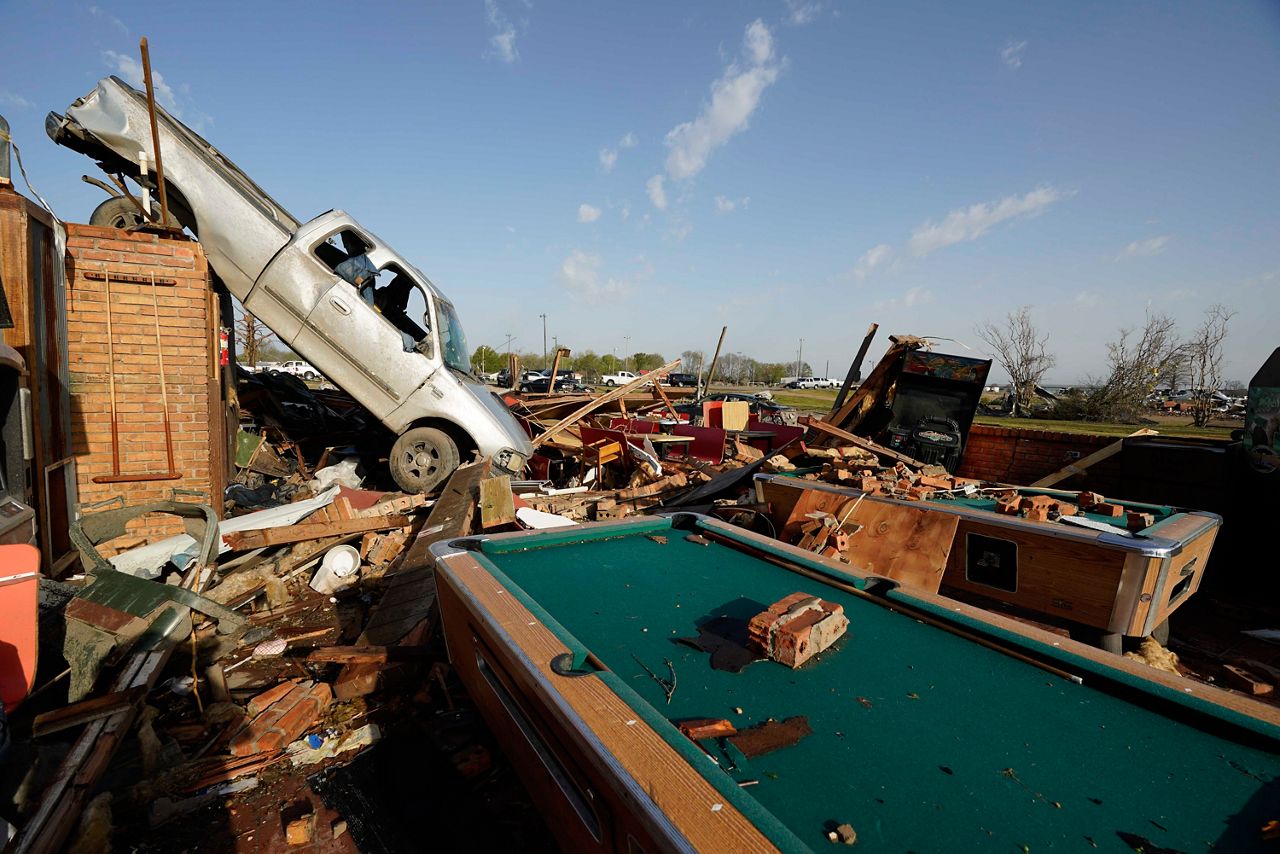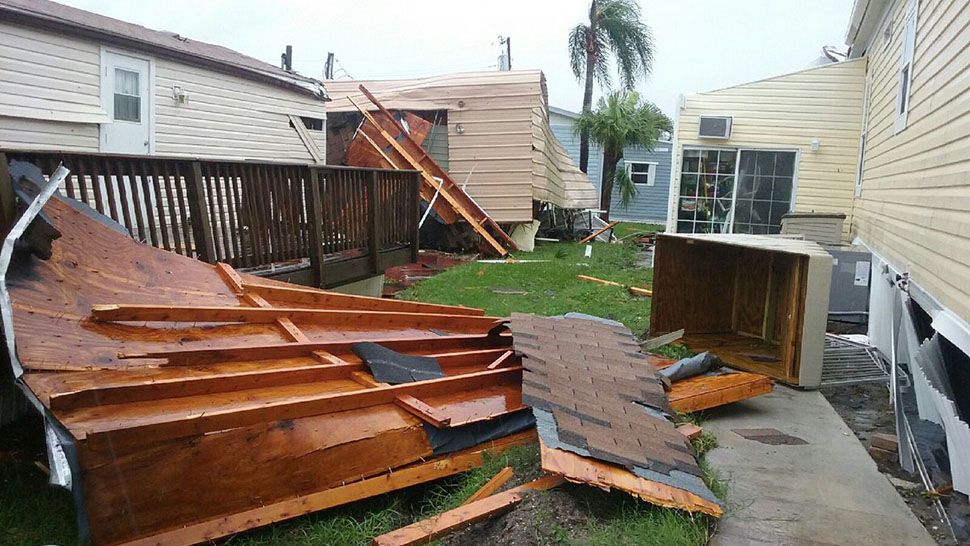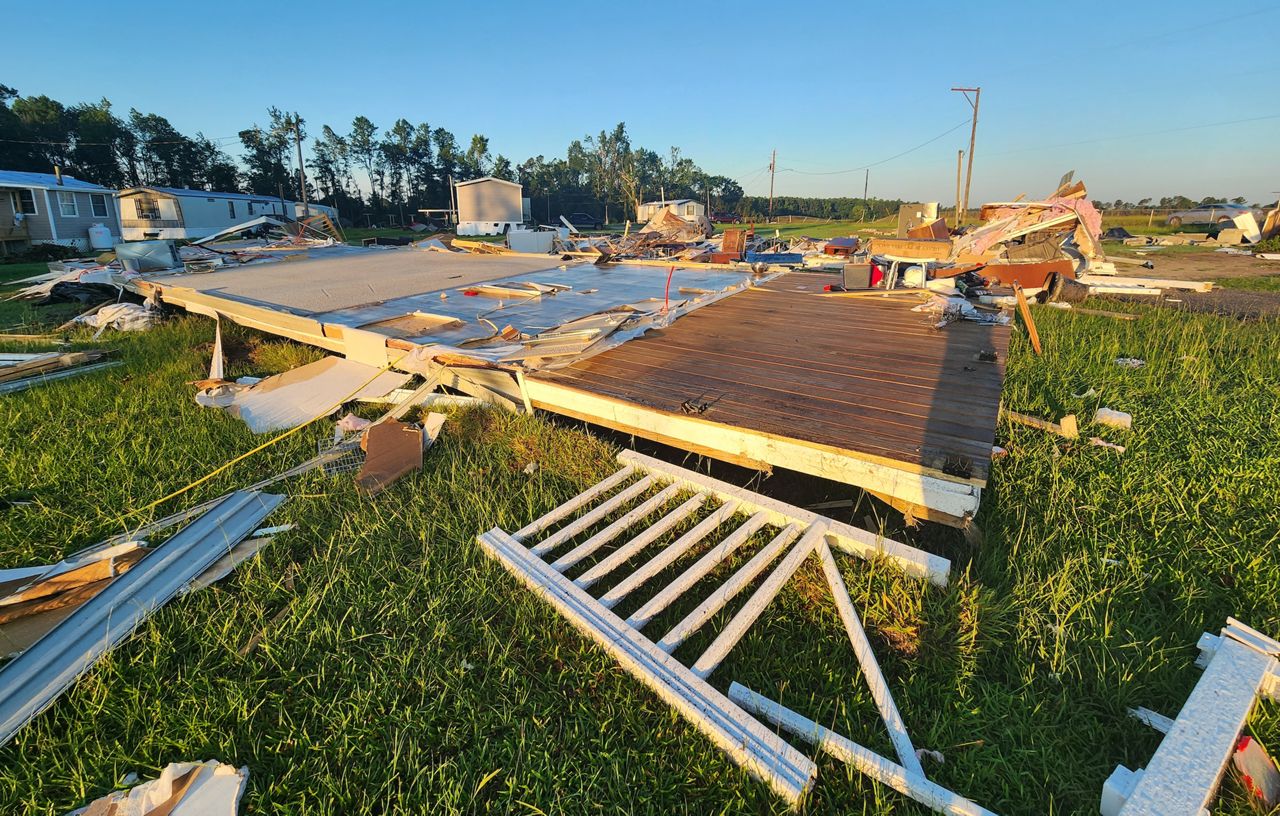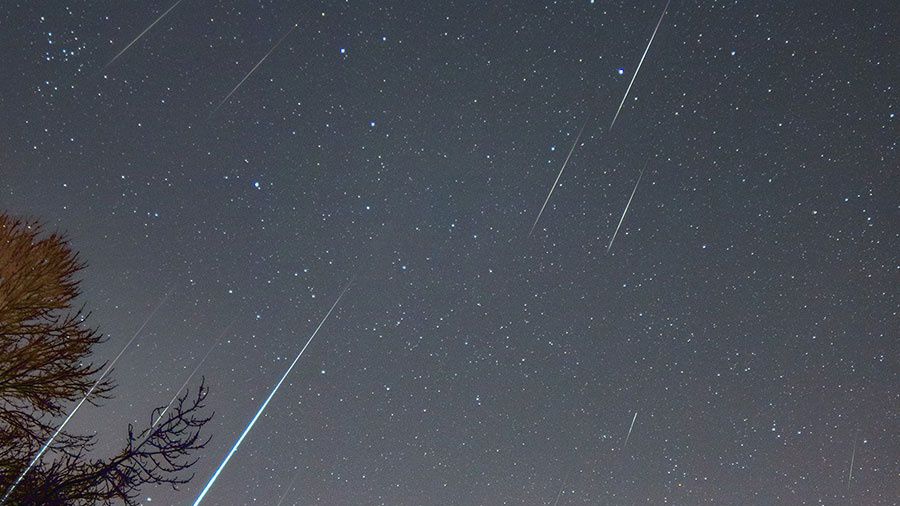ROLLING FORK, Miss. (AP) — Many were not just killed at home. They were killed by their homes.
Angela Eason had visited Brenda Odoms’ tidy mobile home before. It was a place where Odoms, who had many tragedies in her life, felt safe.
In March, a tornado ripped through this small Mississippi town and people in mobile or manufactured homes were hit the hardest. Inside a mobile morgue, Eason, the county coroner, examined Odoms’ gaping fatal head wound. Odoms was found just outside of her collapsed mobile home that was tossed around by a tornado. Blunt force trauma killed her.
“The one place she felt safe she was not,” Eason said. Fourteen people died in that Rolling Fork tornado; nine of them, including Odoms, were in uprooted manufactured or mobile homes.
Tornadoes in the United States are disproportionately killing more people in mobile or manufactured homes, especially in the South, often victimizing some of the most socially and economically vulnerable residents. Since 1996, tornadoes have killed 815 people in mobile or manufactured homes, representing 53% of all the people killed at home during a tornado, according to an Associated Press data analysis of National Oceanic and Atmospheric Administration (NOAA) tornado deaths. Meanwhile, less than 6% of America's housing units are manufactured homes, according to the U.S. Census Bureau.

While we’ve known the dangers of tornadoes to mobile homes for a long time, and there are ways to mitigate the risk, the percentage of total tornado deaths that happen in mobile homes has been increasing. Part of the problem is that federal housing rules that call for tougher manufactured home standards, including anchoring, only apply in hurricane zones, which are mostly in Florida and several counties along the coast. Those are not the areas where tornadoes usually hit.
Auburn University engineering professor David Roueche called manufactured homes in non-coastal places "death traps compared to most permanent homes" when it comes to tornadoes.
The first tornado deaths this year were in Alabama in January, killing seven people, all in mobile homes. The tornado threw all but one person at least 1,000 feet from their homes, with the seventh person thrown at least 500 feet, said Ernie Baggett, the former emergency management chief for Autauga County, Alabama. Less than 100 yards from where four of those people died was a permanent home that had little more than shingle damage, he said.
When the wind hits the mobile homes, “it’s like a house of cards. They just crumble,” Baggett said.
So far this year, at least 45 of the 74 people killed in the U.S. by tornadoes were in some form of manufactured housing when they died, according to NOAA data. Nine others died in site homes and the rest died in other places, such as in vehicles.

The manufactured housing industry—which disputes that there’s any disproportionate danger—insists on calling the structures manufactured homes if they are built after hurricane-based federal standards in 1976 and mobile homes if they are built before, saying age of the home matters. Federal housing officials use the term manufactured housing. Other people, including many researchers and residents, use the terms interchangeably.
More than 70% of the 8 million manufactured homes in America were built after 1976. Because a big chunk of those homes were built in the 1980s and early 1990s, 60% of all those homes were installed before increased federal standards were adopted in 1994, the industry’s trade group, Manufactured Housing Institute said.
Tornado experts say most tornadoes should be survivable.
“You just have to be in some structure that’s attached to the ground. And then no matter what the tornado throws at you, you have really good odds,” said NOAA social scientist Kim Klockow-McClain.
But in manufactured homes, even the weakest tornadoes are killing people in large numbers when they shouldn’t be, according to more than a dozen experts in meteorology, disasters and engineering that talked to the AP.
More than 240 people in mobile homes in the past 28 years have died in tornadoes with winds of 135 mph or less, the three weakest of the six categories of twisters, the AP analysis found. That’s 79% of the deaths at home in the weaker tornadoes. It's only in storms with winds higher than 165 mph where most of the at-home deaths are in more permanent structures.
Auburn’s Roueche not only studies what happens in mobile homes during tornadoes; he grew up in one. What he sees over and over are mobile homes that fail from the bottom up because they are not secured enough to the ground, like permanent homes are.
“The whole structure is rolling or flying through air. You’ve got dressers falling on top of you. You’ve got the entire structure that’s trying to crush you," said Roueche.
That March evening in Rolling Fork when the tornado roared through, Ida Cartlidge remembered the air blowing so powerfully that she couldn't breathe, the sounds of windows shattering and then utter mayhem.
“The only thing that’s holding a mobile home down are the little straps in the ground,” Cartlidge said. “It picked up the home one time, set it down. It picked it up again, set it down. It picked it up a third time, and we were in the air.”
The tornado hit Mildred Joyner's mobile home so hard she felt the mobile home shake, heard the cracking sound of what she figured was her home coming apart and then she woke up in the hospital and her mother, who was in the mobile home with her ended up paralyzed from the waist down.
The problem is worsening in the South because tornadoes have been moving more from the Great Plains to the mid-South in recent decades and will likely to continue to do so with climate change a possible factor, studies show. Alabama has the most tornado deaths by far.
Unlike the rest of the country, which usually has most manufactured housing in parks, the South has mobile homes scattered about the countryside in ones and twos, making central tornado shelters less effective and likely to be built, said Villanova University tornado expert Stephen Strader and Northern Illinois meteorology professor Walker Ashley.
One thing scientists, emergency managers and the manufactured housing industry agree on is that anchoring mobile homes to the ground is key.
That requires expensive concrete or expensive tie down systems, said former Alabama emergency official Jonathan Gaddy, now a professor at Idaho State University.
“Why does that matter? Well, it explains why we haven’t fixed the problem with anchoring because nobody can fix the problem and still make money. That’s the bottom line,” Gaddy said.
“Anchoring matters and has been shown to be the difference between life or death,” Villanova’s Strader said in an email. “However, the MH industry seems disinterested in addressing this because it would make their homes more expensive.”
Manufactured Home Institute Chief Executive Officer Lesli Gooch said the industry is “very clear” about the importance of anchoring. “We also talk about making sure that a professional checks your anchoring systems on your manufactured home, especially on mobile homes built prior to (19)76,” she said.
“We’re very focused on making sure that there are minimum installation standards in the states,” Gooch said.
Northern Illinois’ Ashley said lack of state regulations and inspections, especially in much of the South, is a big problem.
Improvements in federal codes that went into effect in 1976, 1994 and 2008 make a big difference, Gooch said, arguing that the NOAA data the AP analyzed and that scientists use lump different ages of manufactured homes together and tar them with the problems of the oldest ones.
“I wouldn’t want your readers to misinterpret your data to suggest that living in a manufactured home is somehow more deadly than living in a site-built home because I would tell you that I don’t think that the data bears that out,” Gooch said.
Gooch pointed to manufactured homes in Florida, where tighter federal Housing and Urban Development safety rules apply because it is a hurricane wind zone. “Homes in Florida that are manufactured homes are performing better than what you see in the site-built world,” she said.

Several scientists and engineers said data, and history, show the situation has not improved.
“This is more of the handwaving- and misdirection-type statements that has come to represent the manufactured housing industry’s take on tornado and manufactured home safety,” Villanova’s Strader said in an email, with Northern Illinois’ Ashley agreeing.
“Our study of the Lee County, Alabama EF4 tornado found that 19 of the 23 deaths were in manufactured homes (all built after 1994),” Strader said. “All of those deaths were due to a lack of anchoring or a floor-to-wall connection. There have been many prior studies that have illustrated that these homes are failing at lower wind loads than permanent homes.”
If Gooch were right, the percentage of tornado deaths in mobile homes would go down with time and they are not, NOAA National Severe Storms Lab tornado scientist Harold Brooks said, presenting data that goes back to 1975. His data showed mobile home deaths between 1975 and 1984 were 43.6% of all at-home tornado deaths, and the same figure was 63.2% for the past ten years through the end of May.

A contributing factor, Strader, Ashley and Roueche said, is that federal rules for anchoring only apply in hurricane zones, mostly in Florida. Those are not the areas where tornadoes usually hit. Instead, they hit inland where the weakest federal standards are, they said. Most of tornado-prone areas, including almost all of Alabama, Oklahoma, Missouri, Texas and Mississippi are in “Zone 1,” where safety and anchoring of mobile homes have the most lax standards.
“People are dying in new and old Zone 1 manufactured homes,” Roueche said in response to Gooch’s comments. "Homes throughout the country would be much safer if the coastal federal requirements applied everywhere, he said.
One of the issues with mobile homes and tornadoes is that it is an intersection of risk and “different social vulnerability factors like poverty, even some issues pertaining to race, ethnicity, age,” NOAA’s Klockow said.
And it makes it harder for people to leave their mobile homes and head for a permanent shelter.
“I always think about the single mother who’s living in a manufactured home. It’s the middle of the night. She has three kids. Her car’s not starting correctly and all of a sudden here comes a tornado,” Strader said in an interview.
Officials tell her “to get to a storm shelter because our manufactured home isn’t safe,” Strader said. “Well, the problem there is that there’s all these factors up against them.”
Tornadoes pop down rapidly, which doesn't allow meteorologists to give much warning, maybe 10 to 15 minutes. In many cases, the National Weather Service warns days in advance that the conditions are ripe for tornadoes, but that isn't the same as warning that one has touched down.
University of Oklahoma social scientist Justin Sharpe, who studies disaster warnings, said with poor and disabled residents the key is to avoid warnings that simply say “get out now” and nothing else.
Instead, a couple hours before a tornado is possible, meteorologists should warn people to be packed up and ready to go at a moment’s notice later, Sharpe and Klockow-McClain said.
A relatively new law in Alabama could help provide more shelters and be a model for other states. The law gives liability protection to buildings like churches and stores that open up in an emergency as a shelter if specifically built shelters aren’t available.
When this year’s first deadly tornado struck just outside Montgomery, Alabama, Autauga County had about 30 minutes warning but no “safer places” to send people, the then-emergency chief, Baggett said. Seven people in mobile homes died.
The tornado continued into neighboring Elmore County, which had already set off its 30 warning sirens, used a mass notification system to make 16,772 calls to phones in the danger area and opened up 16 churches and other safer places.
People went into the temporary shelters. The tornado destroyed homes, but no one died.
Our team of meteorologists dives deep into the science of weather and breaks down timely weather data and information. To view more weather and climate stories, check out our weather blogs section.
Justin Gehrts - Senior Weather Producer
Justin Gehrts is a senior weather producer for Spectrum News. He has well over a decade of experience forecasting and communicating weather information. Gehrts began his career in 2008 and has been recognized as a Certified Broadcast Meteorologist by the American Meteorological Society since 2010.









